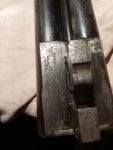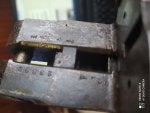I would be happy to help you identify the pattern of Damascus and Twist barrels, or the composition of the steel used in your pre-1920s shotgun barrels. You can likely do so by reviewing the resources listed below:
Crolle Patterns - Terminology and Counting Scrolls
https://docs.google.com/document/d/1zMm ... 2XVfc/edit
Damascus Pattern Classification
https://docs.google.com/document/d/1IHG ... vv0fE/edit
Damascus Pattern Rosetta Stones - Named Pattern Identification
https://docs.google.com/document/d/1tXv ... r8uy8/edit
For more pattern examples, please look under "Art" in the Table of Contents here
https://sites.google.com/a/damascusknow ... m/www/home
For information and identification of vintage steel barrels please see
https://docs.google.com/document/pub?id ... l8GsAWd-KI
https://docs.google.com/document/d/1dnR ... tPYVA/edit
You will need to accurately describe any marks/names on the shotgun action and barrel; a picture would be even better

Please do not post here if seeking information regarding the SAFETY of vintage barrels; see https://www.shotgunworld.com/bbs/viewto ... 5&t=366087
For vintage SHOTGUN identification see
https://www.shotgunworld.com/bbs/viewto ... 5&t=423424
In order to identify your Damascus pattern, you MUST post a full size, in focus, high resolution, close up image; like this

I only need to see about 9" of barrel and please pick the section where the contrast is most apparent. Images are best taken outdoors with partial sun.
More than 100 year old pattern welded barrels usually turn "plum" with age, and the pattern contrast fades. The contrast may still be apparent in a protected area such as under the forend

If the barrels have been blued at some point (sometimes to conceal the fact that they are Damascus), usually a faint crolle pattern will still be present; at the marker

Or you can dab white vinegar on a soft cotton cloth and rub the barrel in a protected area (under the forend where it will not show) and the blue may fade and contrast show.
Please do not send images to me by email. Cybersecurity is so complex today that I will not open any attachment.
Crolle Patterns - Terminology and Counting Scrolls
https://docs.google.com/document/d/1zMm ... 2XVfc/edit
Damascus Pattern Classification
https://docs.google.com/document/d/1IHG ... vv0fE/edit
Damascus Pattern Rosetta Stones - Named Pattern Identification
https://docs.google.com/document/d/1tXv ... r8uy8/edit
For more pattern examples, please look under "Art" in the Table of Contents here
https://sites.google.com/a/damascusknow ... m/www/home
For information and identification of vintage steel barrels please see
https://docs.google.com/document/pub?id ... l8GsAWd-KI
https://docs.google.com/document/d/1dnR ... tPYVA/edit
You will need to accurately describe any marks/names on the shotgun action and barrel; a picture would be even better

Please do not post here if seeking information regarding the SAFETY of vintage barrels; see https://www.shotgunworld.com/bbs/viewto ... 5&t=366087
For vintage SHOTGUN identification see
https://www.shotgunworld.com/bbs/viewto ... 5&t=423424
In order to identify your Damascus pattern, you MUST post a full size, in focus, high resolution, close up image; like this

I only need to see about 9" of barrel and please pick the section where the contrast is most apparent. Images are best taken outdoors with partial sun.
More than 100 year old pattern welded barrels usually turn "plum" with age, and the pattern contrast fades. The contrast may still be apparent in a protected area such as under the forend

If the barrels have been blued at some point (sometimes to conceal the fact that they are Damascus), usually a faint crolle pattern will still be present; at the marker

Or you can dab white vinegar on a soft cotton cloth and rub the barrel in a protected area (under the forend where it will not show) and the blue may fade and contrast show.
Please do not send images to me by email. Cybersecurity is so complex today that I will not open any attachment.






















